Unit Normal Vector
We noted above that T′(t) and T(t) are orthogonal. The unit vector in the direction of T′(t), assuming it is nonzero, is called the unit normal vector and is denoted N(t) or simply N:

Furthermore, ∥T′(t)∥ = υ(t)κ(t) by Eq. (2), so we have

Intuitively, N points the direction in which the curve is turning (see Figure 11). This is particularly clear for a plane curve. In this case, there are two unit vectors orthogonal to T (Figure 10), and of these two, N is the vector that points to the “inside” of the curve.

EXAMPLE 5: Unit Normal to a Helix
Find the unit normal vector at  to the helix r(t) = 〈cos t, sin t, t〉.
to the helix r(t) = 〈cos t, sin t, t〉.
Solution The tangent vector r′(t) = 〈− sin t, cos t, 1〉 has length  , so
, so
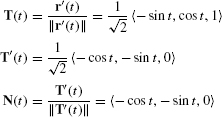
Hence,  (Figure 11).
(Figure 11).
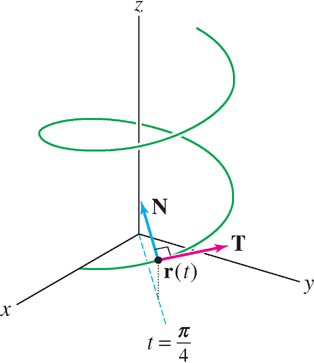
 on the helix in Example 5.
on the helix in Example 5.We conclude by describing another interpretation of curvature in terms of the osculating or “best- where the curvature κP is nonzero. The osculating circle, denoted OscP, is the circle of radius R = 1/κP through P whose center Q lies in the direction of the unit normal N (Figure 12). In other words, the center Q is determined by
where the curvature κP is nonzero. The osculating circle, denoted OscP, is the circle of radius R = 1/κP through P whose center Q lies in the direction of the unit normal N (Figure 12). In other words, the center Q is determined by
751

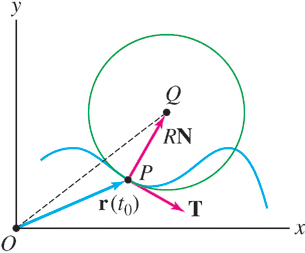
 from P in the normal direction.
from P in the normal direction.Among all circles tangent to  at P, OscP “best fits” the curve (Figure 13; see also Exercise 71). We refer to R = 1/κP as the radius of curvature at P. The center Q of OscP is called the center of curvature at P.
at P, OscP “best fits” the curve (Figure 13; see also Exercise 71). We refer to R = 1/κP as the radius of curvature at P. The center Q of OscP is called the center of curvature at P.

EXAMPLE 6
Parametrize the osculating circle to y = x2 at  .
.
Solution Let f(x) = x2. We use the parametrization

and proceed by the following steps.
Step 1. Find the radius.
Apply Eq. (5) to f(x) = x2 to compute the curvature:

The osculating circle has radius  .
.
Step 2. Find N at  .
.
For a plane curve, there is an easy way to find N without computing T′. The tangent vector is r′(x) = 〈1, 2x〉, and we know that 〈2x, −1〉 is orthogonal to r′(x) (because their dot product is zero). Therefore, N(x) is the unit vector in one of the two directions ± 〈2x, −1〉. Figure 14 shows that the unit normal vector points in the positive y-

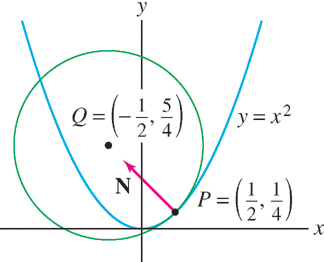
 has center Q and radius
has center Q and radius  .
.Step 3. Find the center Q.
Apply Eq. (8) with  :
:

Step 4. Parametrize the osculating circle.
The osculating circle has radius  , so it has parametrization
, so it has parametrization

If a curve  lies in a plane, then this plane is the osculating plane. For a general curve in three-
lies in a plane, then this plane is the osculating plane. For a general curve in three-
To define the osculating circle at a point P on a space curve  , we must first specify the plane in which the circle lies. The osculating plane is the plane through P determined by the unit tangent TP and the unit normal NP at P (we assume that T′ ≠ 0, so N is defined). Intuitively, the osculating plane is the plane that “most nearly” contains the curve
, we must first specify the plane in which the circle lies. The osculating plane is the plane through P determined by the unit tangent TP and the unit normal NP at P (we assume that T′ ≠ 0, so N is defined). Intuitively, the osculating plane is the plane that “most nearly” contains the curve  near P (see Figure 15). The osculating circle is the circle in the osculating plane through P of radius R = 1/κP whose center is located in the normal direction NP from P. Equation (8) remains valid for space curves.
near P (see Figure 15). The osculating circle is the circle in the osculating plane through P of radius R = 1/κP whose center is located in the normal direction NP from P. Equation (8) remains valid for space curves.
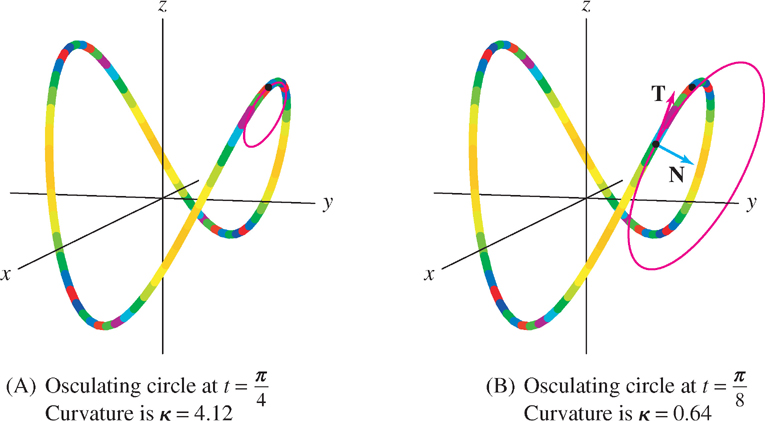
752